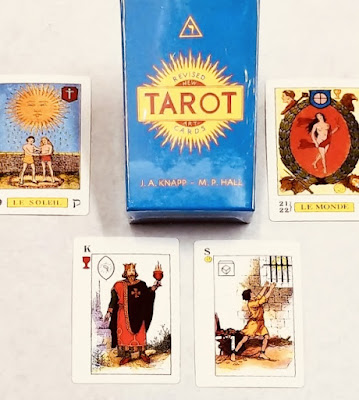 |
| PRS |
It is time for a follow-up to last October’s post about the purported return of the Knapp-Hall tarot deck from the Philosophical Research Society. The PRS now advises there is a delay in shipping, but the decks are available. This is a limited run of 1,500 in a design consistent with the original 1929 printing. Price: $100. From the publicity:
 |
| PRS |
The Revised New Art Tarot aka the “Knapp-Hall Tarot” was originally published in 1929, a collaboration between illustrator & artist John Augustus Knapp (1853-1938) and writer, sage & teacher Manly P. Hall (1901-1990). It was released the year after Hall’s monumental encyclopedia of esoteric traditions and symbols, The Secret Teachings of All Ages, illustrated by Knapp, and over the years this exceedingly rare and beautiful Tarot has come to be known as the Knapp-Hall deck–with original examples selling for thousands of dollars, when they can be found.
It initially was issued with 78 cards, a two-piece, plum fabric-covered box, and a 48-page booklet containing “An Essay on the Book of Thoth” written by Hall. The Knapp-Hall Tarot Deck has been re-printed several times over the years but always with different dimensions and new designs for the reverse of the cards. For this Limited Edition of 1,500, we have replicated the graphics, texture, feel and dimensions of the original 1929 Revised New Art Tarot as closely as possible given modern printing methods. Card images were taken from scans of an original 1929 deck with only minimal corrections for wear and tear. The sepia tone of the card stock, due to aging, has been preserved to reflect what a 1929 deck would look like today.
Please note that this beautiful Tarot is smaller and more delicate than most modern decks, so treat it with care in handling. Any imperfections in the cards (for example, the Knight/Warrior of Pentacles has a smaller border than the other cards) are present in the original 1929 deck scanned for this edition.























































































